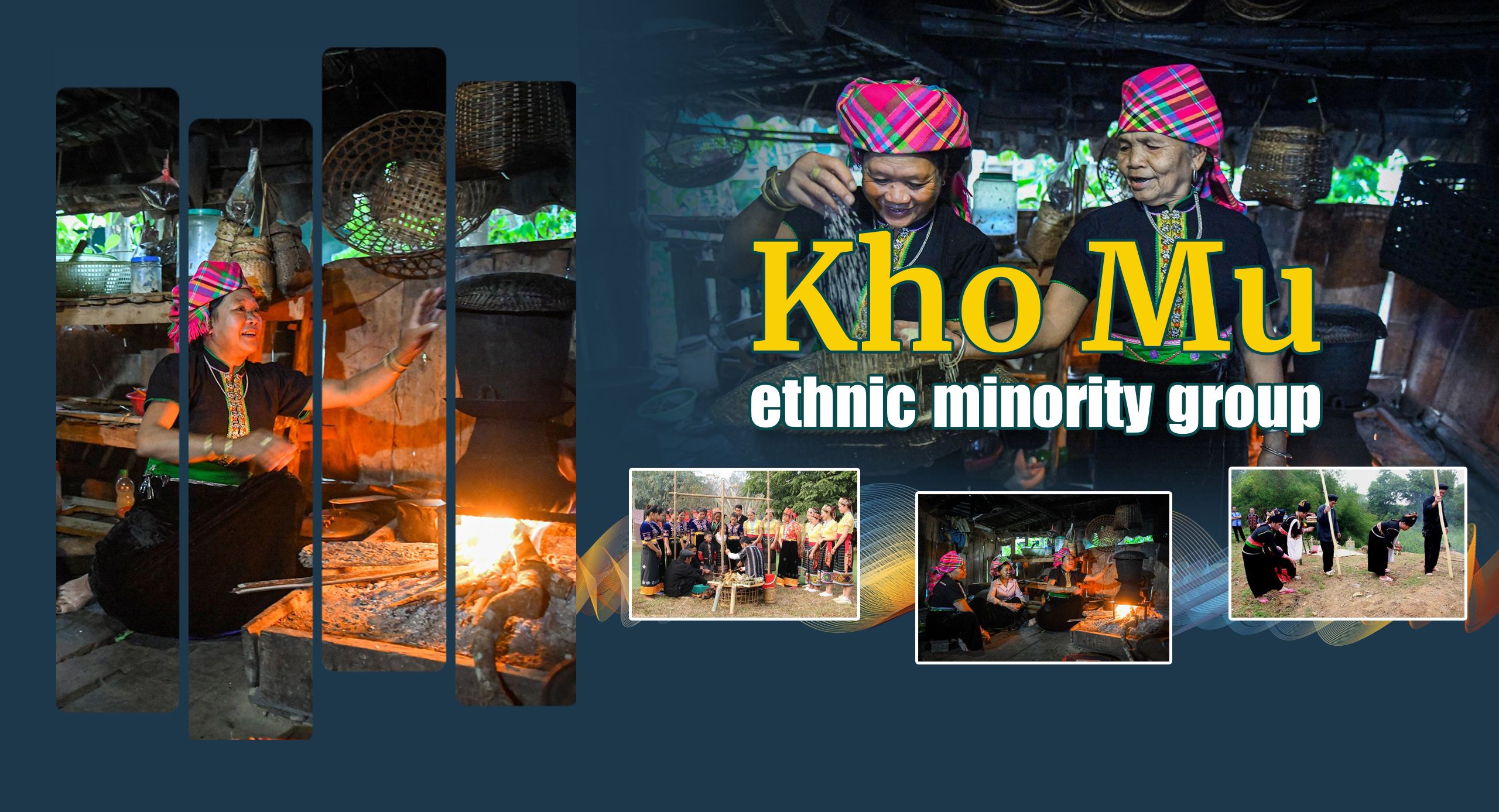
Kho Mu people live in the provinces along the Vietnam - Laos border such as Nghe An, Thanh Hoa, Son La, Lai Chau, and Dien Bien. They live mainly by cultivation. Most of the Kho Mu people have settled agriculture.
• Other names: Xa Cau, Kha Klau, Mang Cau, Tay Hay, Mun Xen, Pu Thenh, and Tenh.
• Language: The language belongs to the Mon-Khmer group in the Austroasiatic language family. Many people can read and write in the Thai language.
• Residence: Kho Mu people live in provinces along the Vietnam - Laos border such as Nghe An, Thanh Hoa, Son La, Lai Chau, and Dien Bien.
• History: Some opinions said Kho Mu people are residents in the Northwest region of Vietnam, based on the folk stories of the Kho Mu and Thai people about the origin of mankind born from gourds.
1. History
Regarding the origin story of the Kho Mu ethnic group in Vietnam, there are still a number of different views. Currently, most scientists confirm that Kho Mu people are residents of the Indochinese peninsula, concentrated in Northern Laos, with the largest gathering point in Luang Prabang, and formed a kingdom named Swa or Lawa. After the Lao people migrated down along with the expeditions and people from Yunnan (China) poured down, forcing Kho Mu people to migrate to Thailand and Northwest Vietnam.
Some other opinions suggested that Kho Mu people are residents in the Northwest region in Vietnam, based on the folk tales of the Kho Mu and Thai people about the origin of mankind born from gourds.
Original name: Kmu, Kum Mu meaning "people" or "community of people".
Other names: Xa Cau, Kha Kluu, Mang Cau, Tay Hay, Mon Xen, Pu Thanh, and Tenh.
2. Population
According to census data on 53 ethnic minorities as of 1 April 2019, the total population of Kho Mu people is 90,612, including 45,494 males and 45,118 females. The percentage of population living in rural areas is 97%.
3. Geographical distribution
Kho Mu people live in the provinces along the Vietnam – Laos border such as Nghe An, Thanh Hoa, Son La, Lai Chau, and Dien Bien.
4. Language
Kho Mu people’s language belongs to the Mon-Khmer group in the Austroasiatic language family. Many people can read and write Thai language.
- Education: According to results of 2019 census on ethnic minority groups, as of April 1, 2019, the percentage of Kho Mu people aged 15 years and over who can read and write in general is 65.8%; the net attendance rate for primary school is 100.6%; the net attendance rate of secondary school is 79.2%; the net attendance rate of high school is 26.2%; and the proportion of out-of-school children is 22.8%.
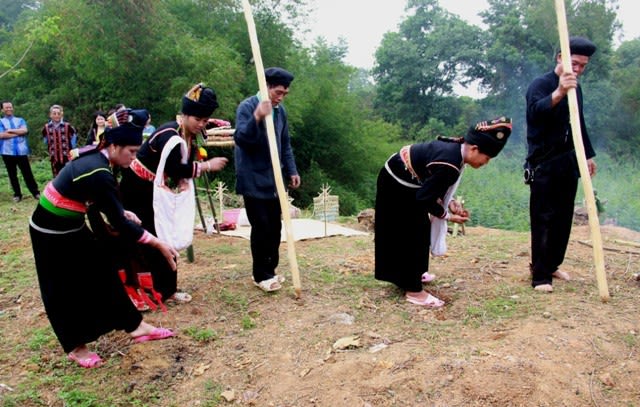
The method of sowing seeds by Kho Mu people in Ang To Commune, Muong Ang District, Dien Bien Province (Photo: Vietnam National Villages For Ethnic Culture And Tourism)
The method of sowing seeds by Kho Mu people in Ang To Commune, Muong Ang District, Dien Bien Province (Photo: Vietnam National Villages For Ethnic Culture And Tourism)
5. Main features
- Cuisine: Kho Mu people often eat sticky rice or corn stuffed with cassava. They like to eat spicy, sour, and bitter dishes as well as grilled foods such as cheo (a kind of dipping sauce), nam pia (a kind of traditional soup), and sour fish.
- Clothing: Kho Mu people wear the same clothes as Thai people, but the difference is the decoration of rows of money and shells on the women's bodice.
- Housing: Kho Mu people live on houses on stilts. Currently, many families have built more spacious and stable houses.
- Social relations: Kho Mu people have a close relationship together and with neighbours, especially Thai people.
Each village consists of many families belonging to different clans. Each family has a leader. Villagers have had a gap between rich and poor. Kho Mu families bear the names of animals, birds, plants, etc., which can be divided into 3 groups of surnames. In addition, there are some families with names of inanimate objects such as pig's basket and soup spoon, etc.
- Marriage: Marriage is conducted according to the principle of mutual consent, especially within a family line. In marriage, many matrilineal remnants still exist such as the custom of husbands living in their wives’ houses and taking their wives' surnames. Men and women are free to love but the right to decide the marriage is up to their parents, especially uncles.
- Funeral: The funeral of Kho Mu people includes many religious rites. Specifically, the ritual to see off the soul of the dead lasts for hours, after which the body is buried.
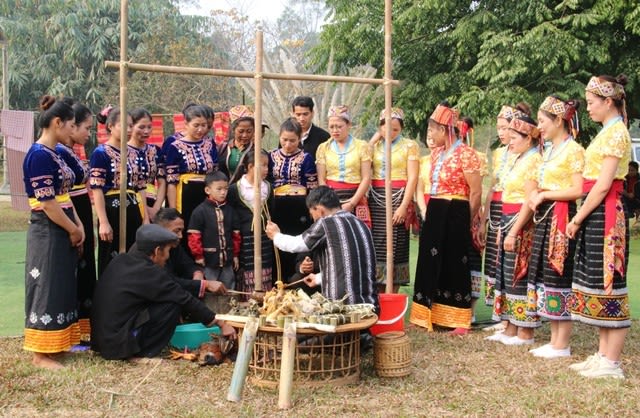
The Go Ro Festival of the Kho Mu ethnic group in Tuong Duong District, Nghe An Province, takes place at the end of the year. (Photo: Vietnam National Villages for Ethnic Culture And Tourism)
The Go Ro Festival of the Kho Mu ethnic group in Tuong Duong District, Nghe An Province, takes place at the end of the year. (Photo: Vietnam National Villages for Ethnic Culture And Tourism)
- New House: Moving to a new house is a joyful occasion for the family and the whole village. The host often slaughter pigs to treat their neighbours in the village. This is an opportunity for villagers to perform community-based cultural activities.
- Festival: In addition to the Lunar New Year, Kho Mu people also celebrate the new rice festival which takes place after the harvest season in the 10th lunar month.
- Worship: Kho Mu people believe that there are five most important types of ghosts: heaven ghost, earth ghost, thuong luong ghost, ancestral ghost, and house ghost. They are the ghosts that bring good things to people, but sometimes if angered, they can cause disaster to punish people. The altar of the house ghost is located in the attic of the kitchen, while their ancestors are worshipped in a private space. Each family still maintains the custom of worshiping their family ghost with their own rituals and movements.
- Calendar: Kho Mu people popularise the way of calculating the date and time based on their typical table for building houses and getting married.
- Arts: The familiar folk song that many people like names Tom. Kho Mu people like to dance and play bamboo flutes and percussions made by themselves, especially lip trumpets.
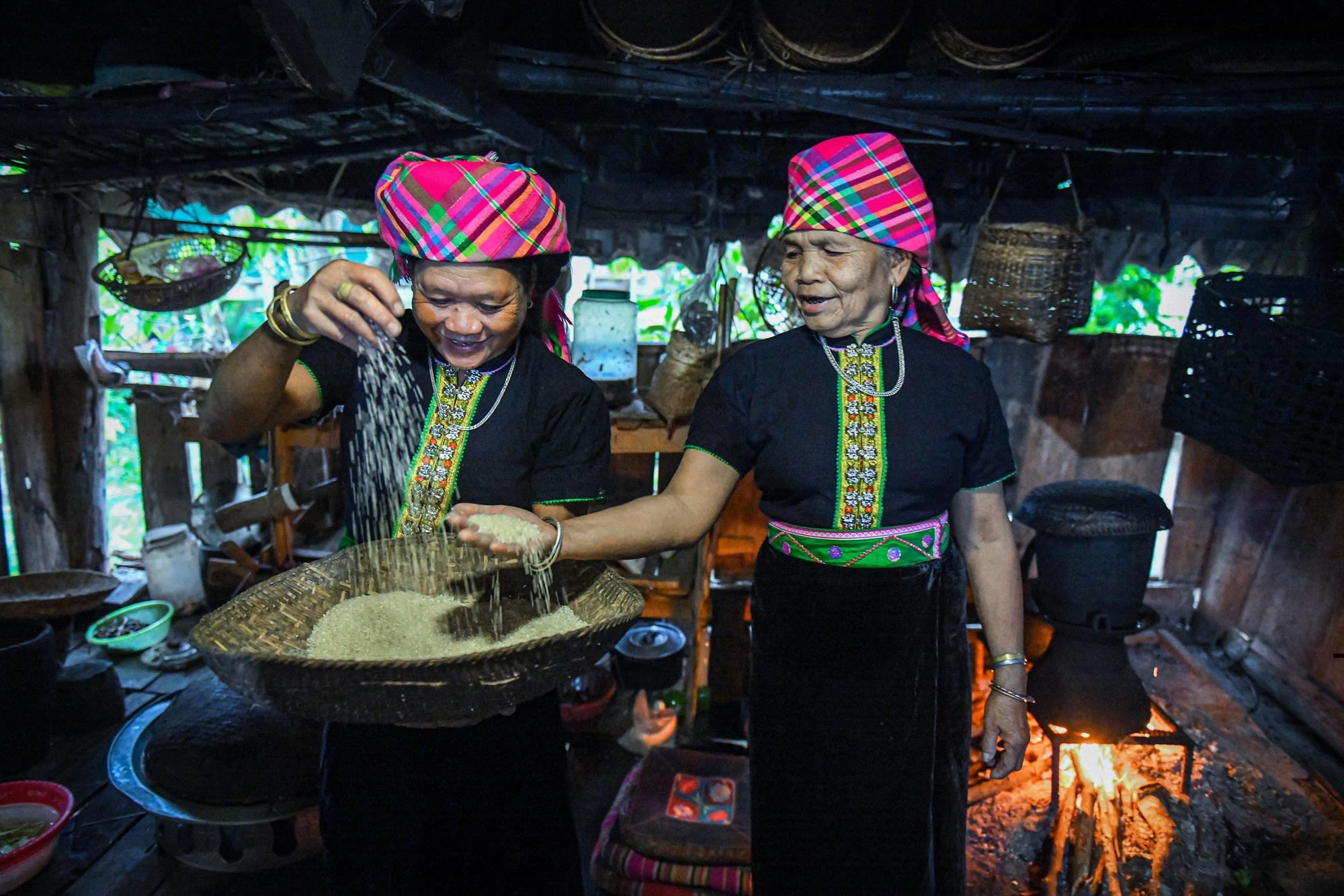
Sticky rice is the main dish of Kho Mu people. In photo: People are preparing rice to blow sticky rice. (Photo: Thanh Dat)
Sticky rice is the main dish of Kho Mu people. In photo: People are preparing rice to blow sticky rice. (Photo: Thanh Dat)
- Residence: Those who are farmers form their own villages that usually lie on the foothills, on terraces, and along beaches. The above sites have the advantage of being close to water sources and are convenient for traffic and transportation. In the villages, those who have houses close to each other are usually relatives.
In urban areas, they tend to form their own Hoa neighborhoods.
Houses usually have three types: houses with three compartments and two wings, houses with shapes like "Mén" and "Kǒu" Chinese characters. They are usually built from stones and bricks, have earthen walls, and have either tiled or thatched roofs.
- Social relations: In a Hoa family, the husband is the head of the household. Community relations are still strong despite the gap between the rich and the poor. In each village, the position of the head of a family line is promoted and plays a big role in resolving village relations.
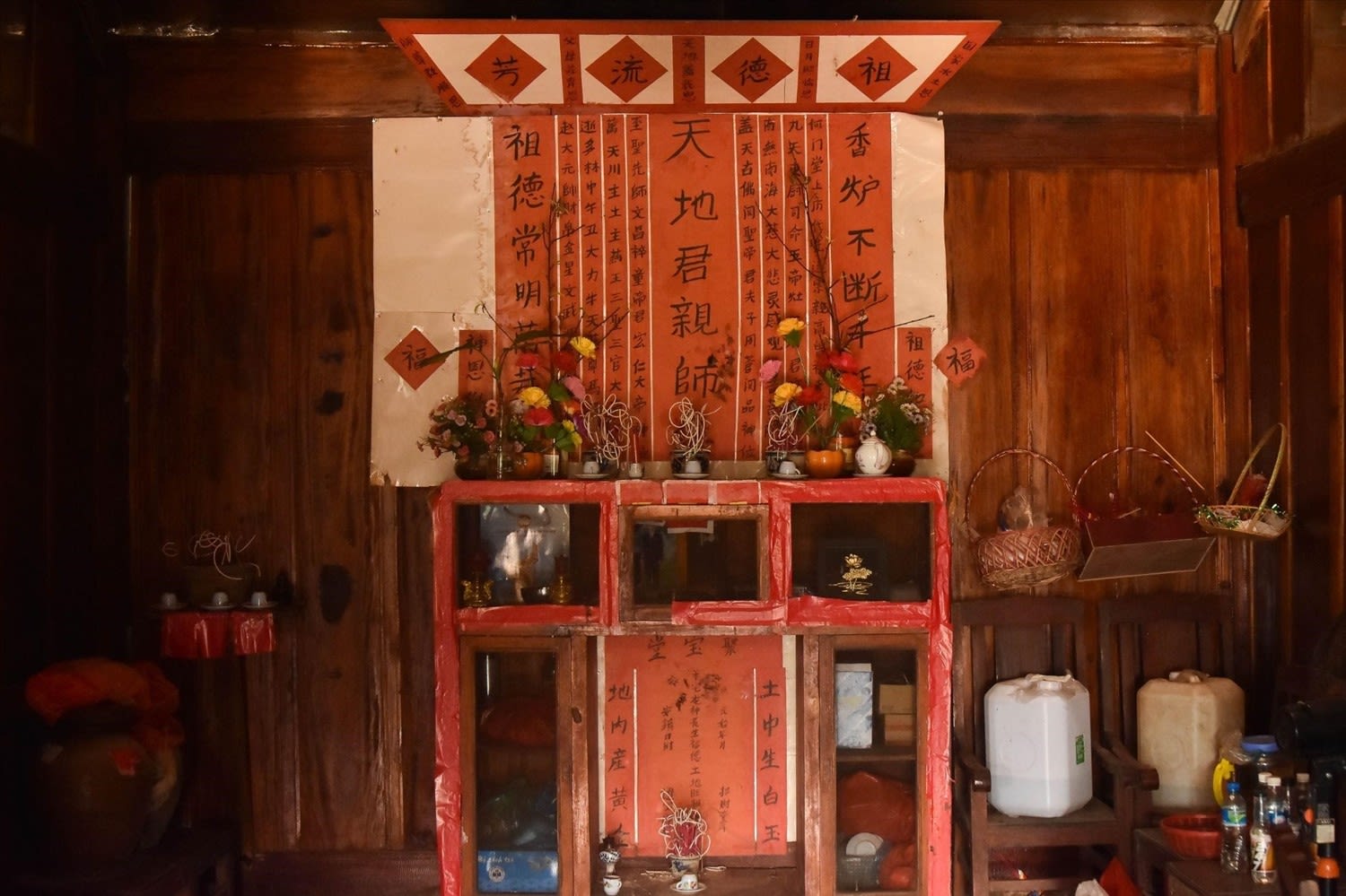
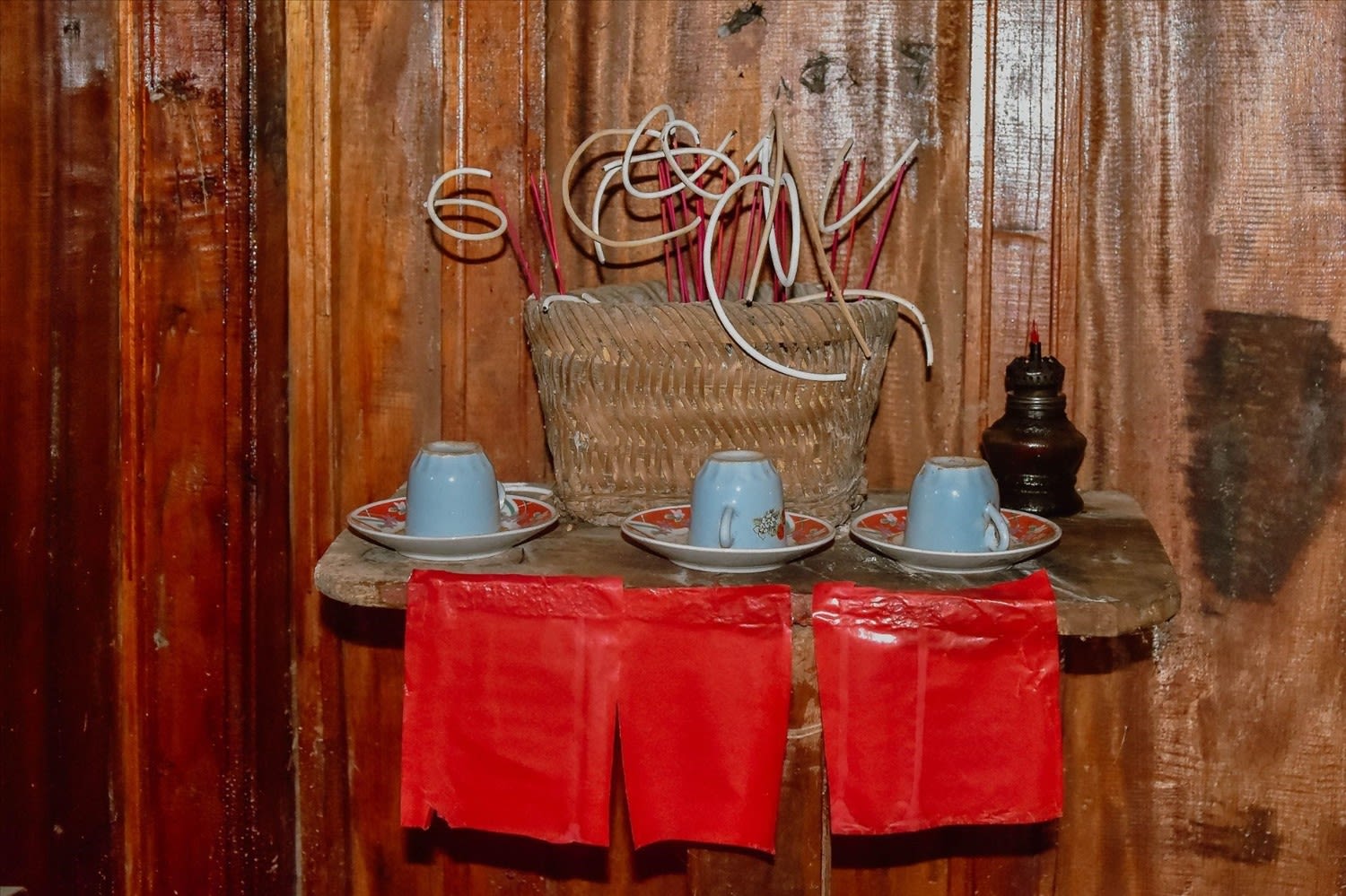

The altar area is placed in the most central position in the Hoa house, with red as the main colour, decorated with more red paper in Chinese characters with the content of praying for happiness, good fortune, and peace. (Photo: baodantoc.vn)
The altar area is placed in the most central position in the Hoa house, with red as the main colour, decorated with more red paper in Chinese characters with the content of praying for happiness, good fortune, and peace. (Photo: baodantoc.vn)

In addition to the large central altar, the Hoa also have a small altar next to it, placing a bowl of incense and three cups of water on it. (Photo: baodantoc.vn)
In addition to the large central altar, the Hoa also have a small altar next to it, placing a bowl of incense and three cups of water on it. (Photo: baodantoc.vn)
6. Economic conditions
Kho Mu people are residents who live mainly by shifting cultivation. Currently, most of the Kho Mu have settled down. In addition to rice and corn, they grew gourds, beans, and tubers. The families’ side job is knitting household items. People in some places know blacksmithing, carpentry, and weaving. Since the implementation of crop conversion and the expansion of farming areas, many households have escaped poverty and now have a stable economic life.
The rate of poor households is 51.6%, and the proportion of near-poor households is 13.4%. The unemployment rate among Kho Mu group stands at 1.04%; the percentage of trained workers with diplomas and certificates is 3.1%; the proportion of labourers working in the non-agricultural sector is 8.3%; the proportion of labourers working in management or technical qualification at high and middle level is 1.1%; and the proportion of households with traditional crafts is 0.05%.